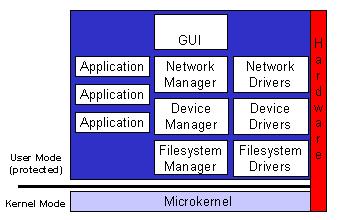Another new “Linux like” embedded OS enters the scene
Dec 22, 2000 — by Rick Lehrbaum — from the LinuxDevices Archive — 4 viewsAs if the embedded software market wasn't crowded enough already, a French startup named NexWave has invented what it hopes will prove to be a better embedded software “mouse trap.” Like LynxOS, QNX, and UnixCE, the new NexCore… embedded software platform will be marketed on the strength of its API compatibility with Linux — but for situations which require smaller footprint, better real-time performance, or a higher degree of modularity than can ordinarily be provided by Embedded Linux. The NexCore kernel, for example, can be as small as 20K bytes in size (or as large as 400K).
Like most companies in the embedded software market today, NexWave says it is targeting its new embedded OS product at “the proliferation of products accessing information.” That, says NexWave, includes a long list of the usual suspects: “set-top boxes, web-phones, and PDAs; consumer electronics (digital TV, DVD players); telecommunications and network products (mobile telephones, routers, IPBX etc.); payment terminals and all types of equipment and terminals needing to communicate intelligently (navigation systems, office automation, computer equipment, robotics).”
A highly modular micro-kernel architecture
NexWave describes NexCore as “a development framework that enables programmers to create a complete software system (including the operating system and application layer), that is constructed entirely from independent and interconnected software components.” Additionally, NexWave says the resulting components are interchangeable and replaceable “on-the-fly” while the system is running, without adversely affecting performance.

“90 percent of microprocessors today go into . . . embedded systems,” explains NexWave COO Daniel Ackerman, “but in over half these products, the operating systems are non-standard, proprietary, and version-specific — in short, a nightmare to support.” It is the designs that to date have not made use of commercial embedded OSes that NexWave is targeting with NexCore. Ackerman believes the high degree of lego-like modularity afforded by the architecture of NexCore and its associated kit of OS components is going to eliminate the need for custom operating environments, thereby reducing risk and improving time-to-market.
In addition to the NexCore microkernel and its associated development tools, NexWave plans to offer a growing library of off-the-shelf software components that handle other common embedded system requirements, including such functions as graphics, networking, and communications, much as ASIC suppliers have libraries of hardware function IP (intellectual property). Currently, NexWave's library of components includes:
- NexCore — the microkernel (20-400 KB)
- [email protected] — a complete HTML 4.0 browser (100-200 KB)
- NexWap — a WAP stack and WAP browser
- NexStack — a complete TCP/IP stack (50+ KB)
- NexGui — a high-performance graphical user interface development tool, which is optimized for embedded applications
NexWave claims that NexCore, based on its support for POSIX, offers Linux compatibility on an API (application program interface) level. In other words, programs must be recompiled in order to move them from Linux to NexCore, or visa versa. According to Ackerman, NexWave will migrate NexCore to full Linux ABI (application binary interface) compatibility within approximately six months — which will, in principle, allow programs to transparently run on either Linux or NexCore, without recompilation.
And one more thing: like the other “Linux-like” OSes, NexCore is not open source.
More about NexWave
NexWave's technology was featured at the recent Mondial de l'Automobile (Automobile 2000) show in Paris, in a Siemens booth dedicated to the convergence of the automobile and the Internet. The demonstration showed a mobile phone with WAP technology, integrated into concept vehicles from the PSA Peugeot Citroën group.
NexWave was founded in 1998 and is based in Montpellier, France. The company currently has a staff of approximately thirty. Based on its recent round of funding, NexWave has started the process of hiring fifty additional employees and plans to open local offices in the US, UK, Germany, and Japan during 2001.
This article was originally published on LinuxDevices.com and has been donated to the open source community by QuinStreet Inc. Please visit LinuxToday.com for up-to-date news and articles about Linux and open source.